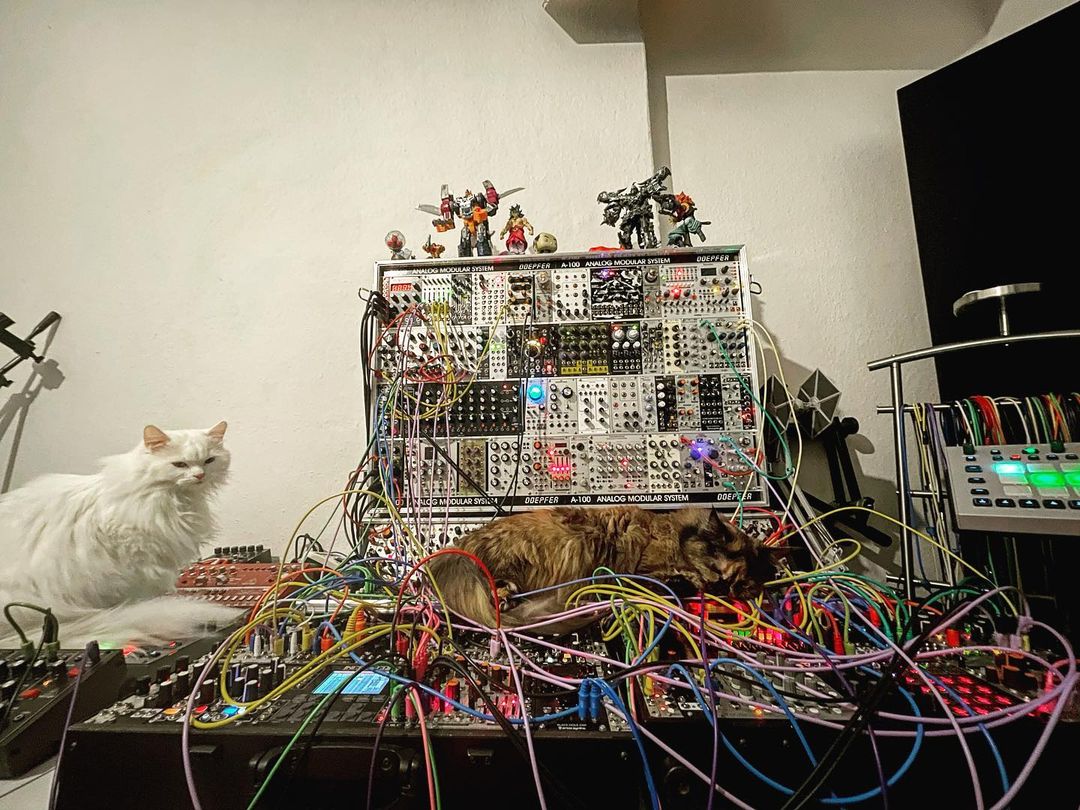
We kick off this week with an epic photo featuring two cats and a massive modular synthesizer system. One of them has decided that the modular is a great spot for a nap.
From blush_response via Instagram.
dreamland🌫


We kick off this week with an epic photo featuring two cats and a massive modular synthesizer system. One of them has decided that the modular is a great spot for a nap.
From blush_response via Instagram.
dreamland🌫
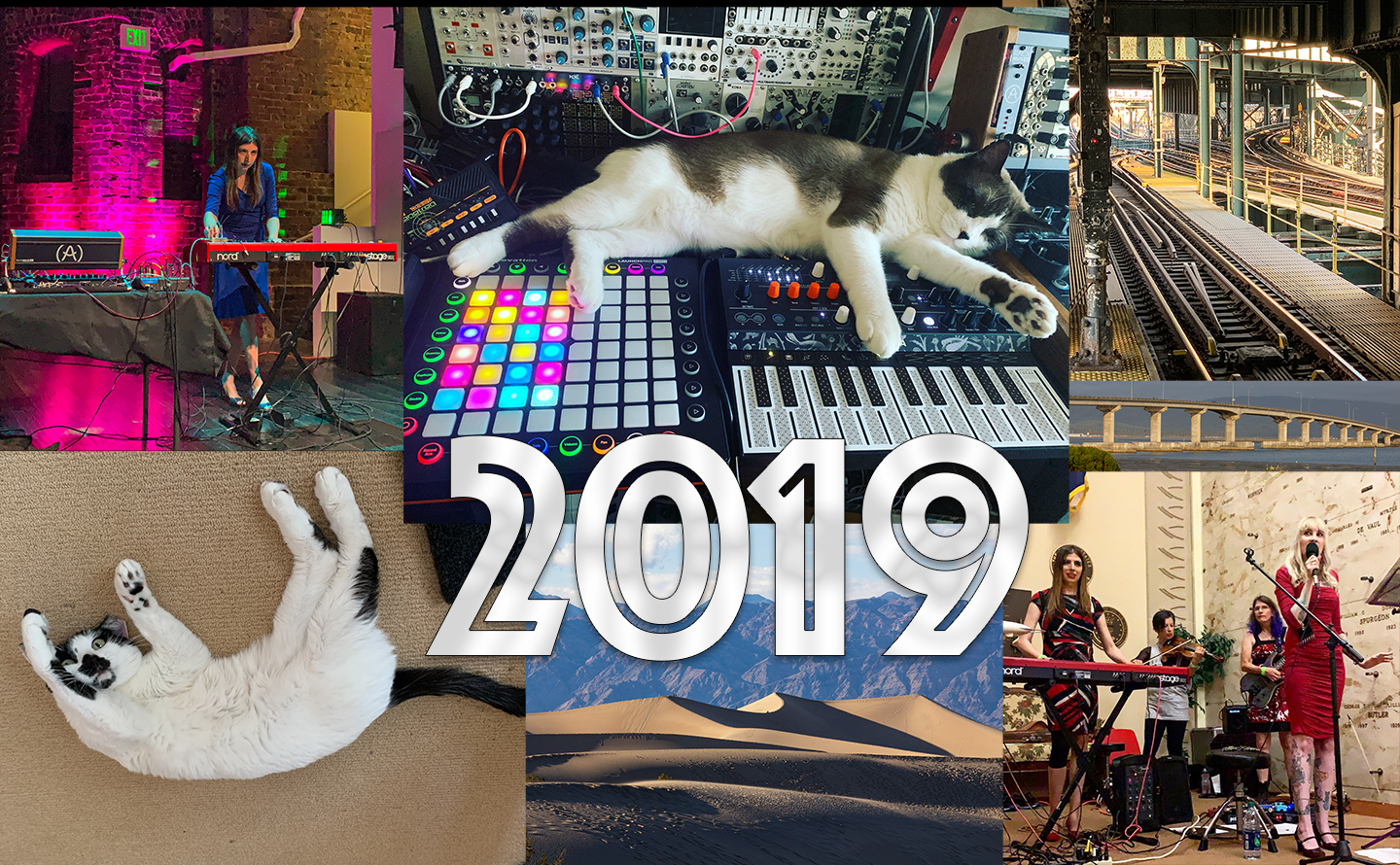
Our year-end collage is a long-standing tradition at CatSynth. And we had a lot of fun making this year’s edition, so many wonderful images to choose from. One of my best solo performances to date took place at the Compton’s Cafeteria series at the Center for New Music. Big Merp came to live with has at CatSynth HQ. And our adventures took us from the halls of NAMM to the bottom of Death Valley to the subways of New York.
As we mentioned at the end of last year, most of the energy has moved to CatSynth TV and our social media platforms (especially our Facebook page). The blog is mostly our core cat-and-synth pics these days, although I do enjoy sharing long-form articles now and then. And In 2020, I do plan to revive the “primary highways” series from eight years ago.
On the video side, things have been going very well. Here are the top videos for 2019:
By early autumn, I was also thinking about this year as a “tipping point.” The transition from the blog to the video channel is the most obvious, but it also applies also on the personal side. The arrival of Big Merp was one of the big stories, and it’s been a tough integration getting both cats to coexist, but things have been trending well in the past few months, with Sam Sam regaining her confidence and HQ becoming a more harmonious place again. Musically, I have moved in a direction that is perhaps closer to my roots in jazz, fusion, funk while maintaining the experimental electronic aspects. I have also moved to a point where studio work is how I spend most of my musical time, between the videos and other projects. Finally, I am getting older, as we all are, and that adds both perspective and a need to focus on health and wellbeing. In 2020, I may “do fewer things” than in the past, but I hope the things I choose to do make an impact both personally and beyond.
There is a lot to look forward to in the coming days: NAMM 2020 is around the corner, I have a full queue of demos to share, and I am laying the foundations for some major musical projects. And of course, we will continue to post cats and synths.
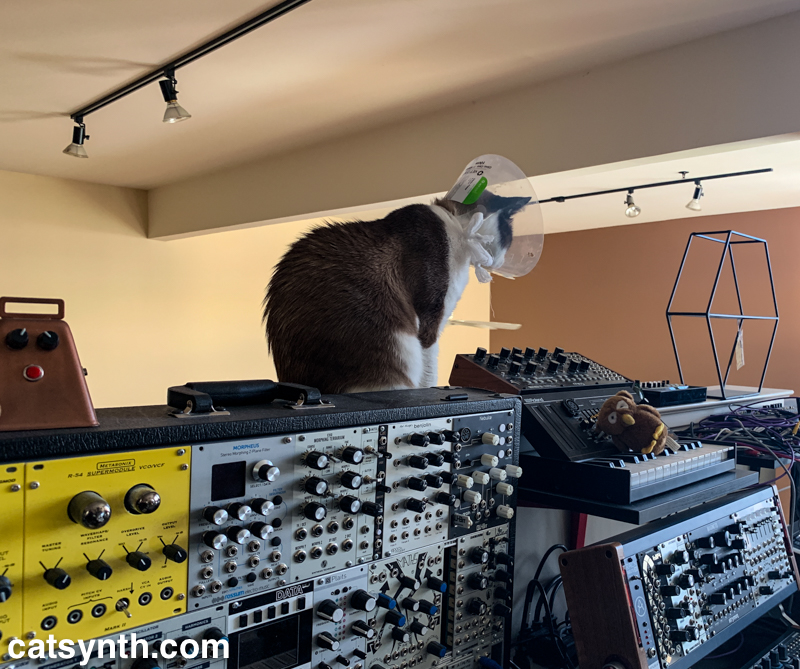
Big Merp jumps up on the ledge behind the modular synths (the main system as well as the RackBrute). Also present are the Deptronics Thunderbell, Moog Mother 32, Roland Boutique VP-03 (with owl), and the Korg Volca Beats.
Poor Merp has had to wear the cone of shame since his surgery on Friday, but as this picture shows, by Wednesday he was feeling much better and back to his regular mischievous self. So we decided to liberate him from the cone.
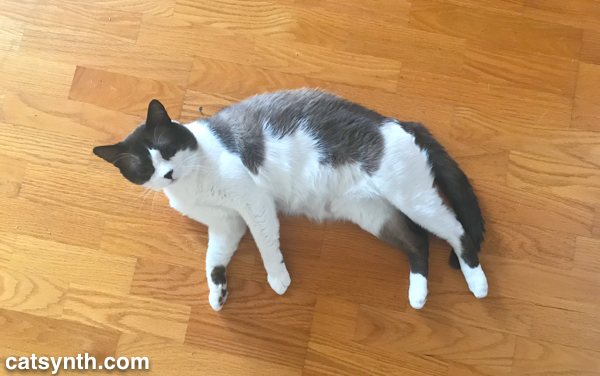
He seems much happier without it 😸
I have attended the Garden of Memory at the Chapel of the Chimes in Oakland many a summer solstice since moving to San Francisco – and written multiple reviews on these pages and even presented a CatSynth TV showcase last hear. But 2019 is the first time I have performed at this annual event as a named artist. It’s a very different experience from the inside looking out. This article describes the adventure.
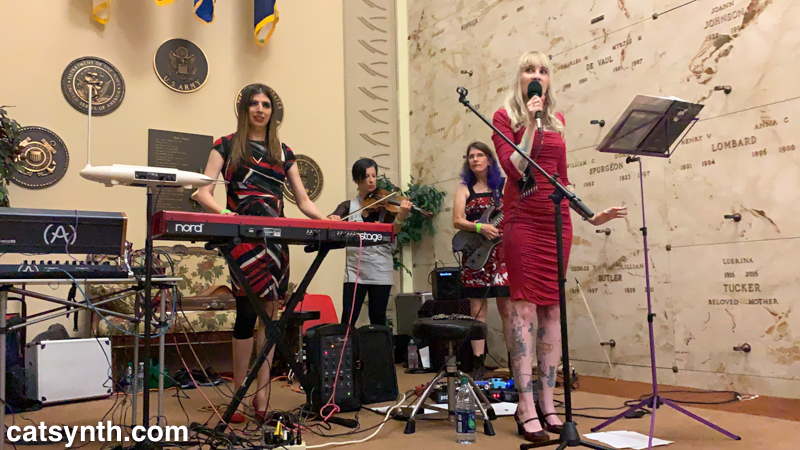
My friend and sometime collaborator Serena Toxicat and I were excited to be accepted into this years program for our project Manul Override. We joined forces once again with Melne Murphy on guitar and also invited Thea Farhadian to sit in with us on violin.
I had a rather elaborate setup, anchored as usual by my trusty Nord Stage EX. The Sequential Prophet 12 has also become a mainstay of my smaller collaborations, providing rich ambient sounds. The Arturia MiniBrute 2, Moog Theremini, and a collection of Eurorack modules rounded out the rig.
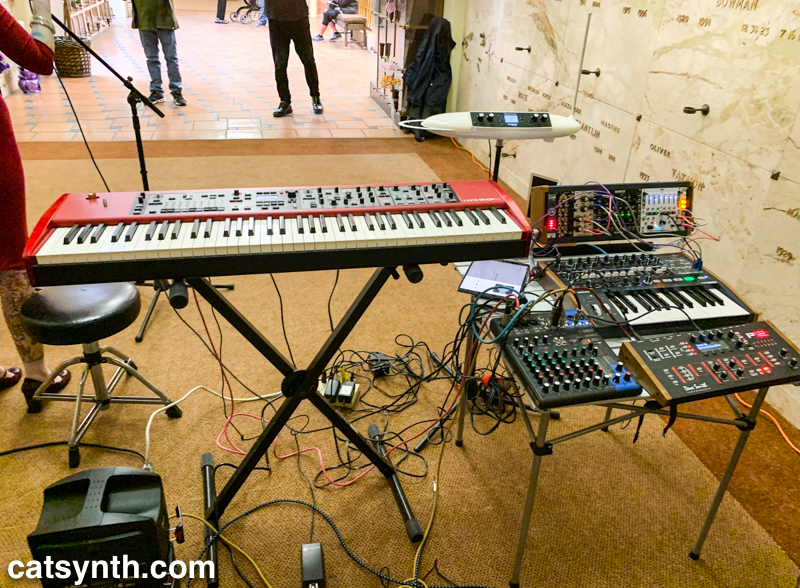
Getting everything into place in the catacombs-like building – a renowned landmark designed by Julia Morgan – was a challenge in itself. Fortunately, I found parking nearby and was able to load everything onto carts or wheeled cases, and had plenty of help getting things downstairs where we were playing.
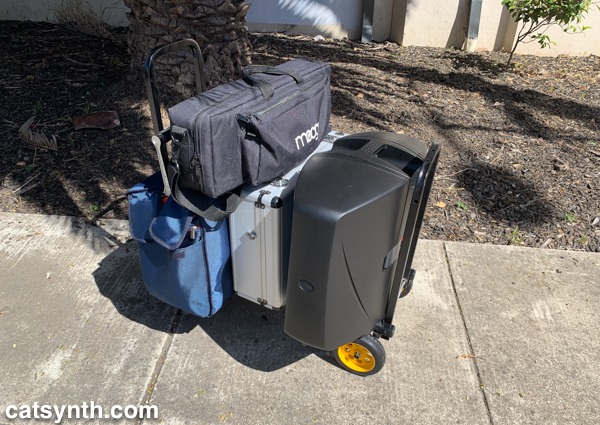
The acoustics of the space are also quite challenging. It is a set of oddly shaped stone chambers, some large, some small, so echoes abound from both the crowds and other performers. Figuring out how to balance our sound is not easy, and I don’t pretend to have gotten it right on the first try, but it’s a learning experience. But we did get ourselves sorted out and ready to play.
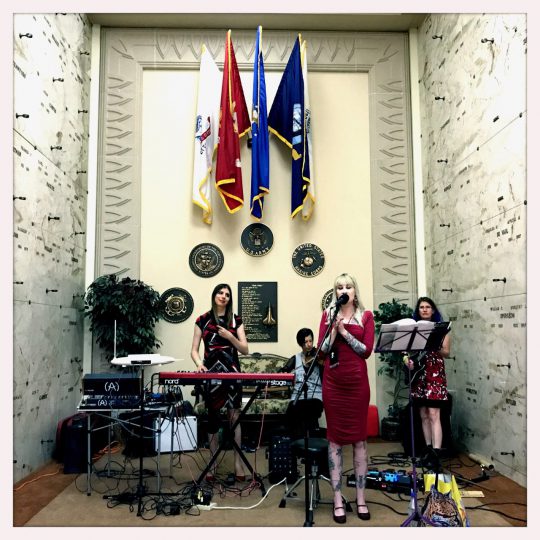
The set unfolded with an invocation, a drone in D mixolydian mode set to Serena’s text Mau Bast, read first in French and then in English. It seemed a perfect piece for the occasion. We then switched things up with a more humorous piece (Let’s Hear it for) Kitties, which was a crowd favorite. You can hear a bit of it in this video from the event.
I have learned how to best follow Serena’s style of speaking and singing, with a more open quality; and Melne and I know how to work together well both in terms of timing and timbre. Thea’s violin added an interesting counterpoint to the voice and electronics. Her sound was sometimes masked by the other instruments and the acoustics but when it came through it added a distinct character and texture. The remaining two pieces were more improvised. One was a free improvisation against one of Serena’s books Consciousness is a Catfish, and another was based on a graphical score with 16 symbols that I first created in 2010 but have revised and reused over the use. The newest version included a cartoon pigeon in honor of my bird-loving co-conspirator Melne.
The performance was well received. Crowds came and went throughout the evening, but many people stayed for extended periods of time to watch us, and others came back a few times. We played two hour-long sets, and in between I had a small amount of time to check out some of the other performs. In particular, I enjoyed hearing Kevin Robinson’s trio, with whom we shared our section of the space.
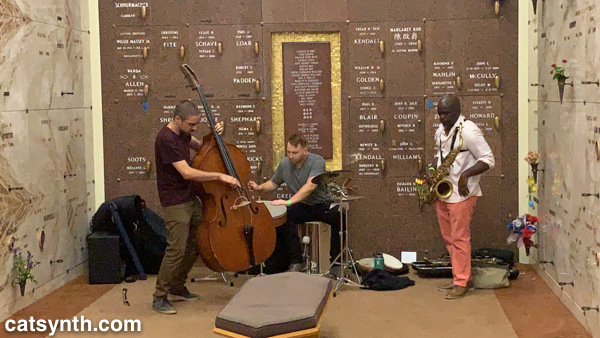
His spare group and arrangements with saxophone, upright bass, and drum, provided a distinct contrast to our thick sound. The moved between long drawn-out tones and fast runs with short notes that reverberated around the space in between. Robinson’s music often has a meditative quality, even when it is more energetic, so it fit well.
Around the corner from us was the Stanford Laptop Orchestra (SLOrk). They had a quiet set featuring performs seated on meditation cushions with laptops as well as various percussive objects as sound sources.
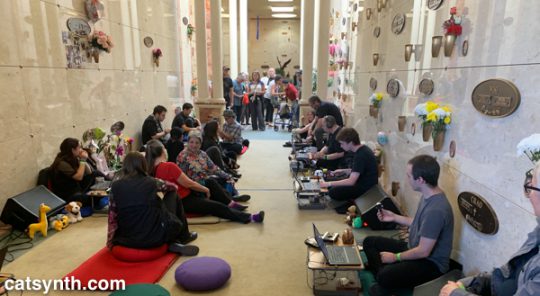
I was particularly inspired by Anne Hege and her Tape Machine, an instrument with a free-moving magnetic tape and several heads, pickups and tiny speakers. She sang into it at various points and moved the tape, created an instrumental piece that was part DIY-punk, part futuristic, and somehow quite traditional at the same time.
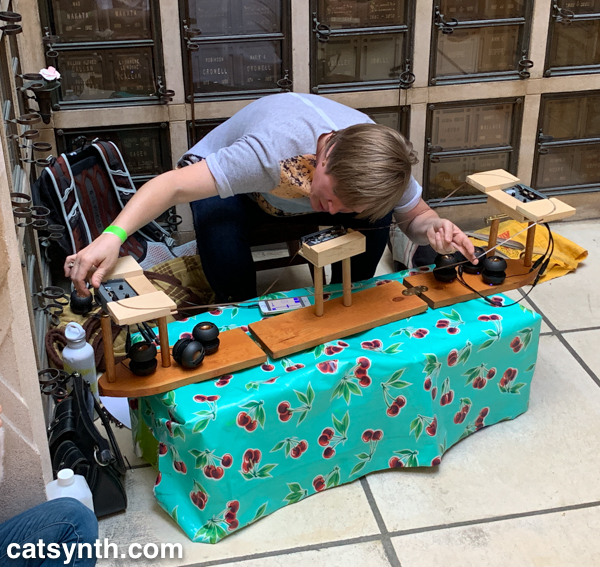
Her performance gave me ideas of a future installation, perhaps even to bring to the Garden of Memory in years to come…
Thea pulled double duty during the evening, also performing as part of a duo with Dean Santomieri, sharing a space with Pamela Z. Our friends Gino Robair and Tom Djll brought the duo Unpopular Electronics to one of the darker columbariums, and IMA (Nava Dunkelman and Amma Arteria) performed on the lower level. In retrospect, our group might have been better placed sharing a space with them, as we are both electronic groups (all women) with large dynamic range.
Overall, it was a wonderful experience, and with the opportunity to play as well as listen it’s my favorite to date. Thank you Sarah Cahill, Lucy Mattingly, and the rest of the crew at New Music Bay Area as well as the Chapel of the Chimes staff for letting us be a part of this event!
Today we look back at this year’s μHausen, a “micro-festival” of experimental electronics that takes place every summer deep at a secure undisclosed location in the Santa Cruz Mountains. It was the subject of our most recent CatSynth TV episode.
As suggested in the video, I was thinking a lot about our natural surroundings as we made music with our thoroughly artificial electronic instruments. The trees, the air, the light, all seemed to be of a piece with the music at times. I also thought about the fact that I had not been able to attend the last three installments. In 2015 and 2016 I had to cancel or decline because of medical issues, and I’m not sure what happened in 2017. But I was back now and was great to see and hear everyone.
First up was Peter Elsea, recently retired from his longtime position as a professor of electronic music at UC Santa Cruz. On this occasion, he performed with a small rig that included a modular synthesizer and an electronic wind instrument.
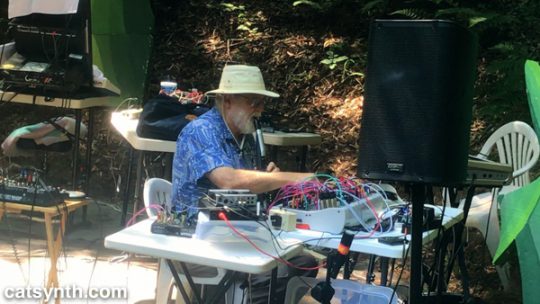
His set featured tones that were timbrally rich and often noisy, but still pitched. This worked well with the wind controller which allowed the noisy tones to swell and fade musically. But there were also some beautiful moments of quiet pure tones that evoked the natural surroundings.
Next up was Later Days, a project featuring Wayne Jackson with his iOS-based evolutionary synth MendelTone, which allows patches to “breed” and evolve.
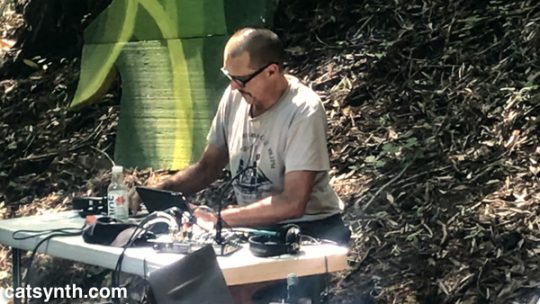
There was an urgent “machine-like” quality to the music, with low drones oms mixing with high swirls of sound and various percussive hits. Wayne is also the founder of this event and often its leader, but this year he ceded organizing duties to R Duck (of the R Duck Show), who performed next.
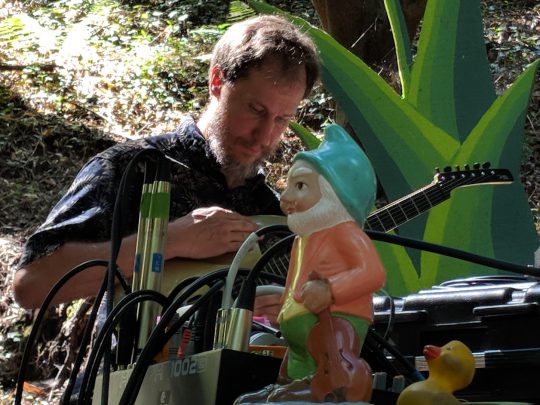
[Photo by Later Days (Wayne Jackson)]
The first segment of his set featured beautiful drones of processed guitar. There were quick runs, but they were absorbed into the overall sound. Over time, the tone and structure darkened, with more complex timbres and harmonies set against slow but anxious guitar riffs. He also teamed up with Later Days to deliver his perennial incantation featuring chocolate. (Did I mention that we at CatSynth love chocolate?)
Next up was synthesizer virtuoso Doug Lynner, who performed on a Eurorack-based Serge modular synthesizer.
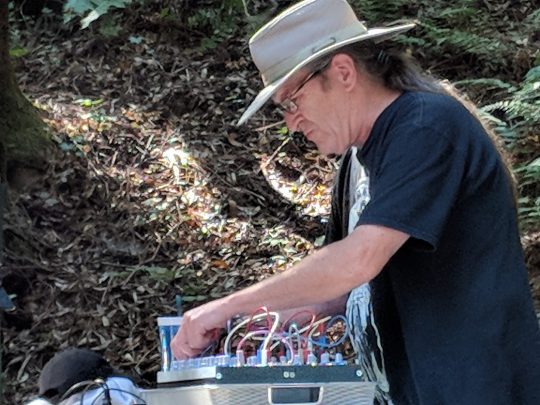
[Photo by Later Days (Wayne Jackson)]
I have long come to expect very complex and intricate sounds from Doug, often set in a very sparse texture where one can clearly hear the details. That was certainly the case in this performance, which opened with light sounds reminiscent of birds and whale songs. It could have come from the surrounding woods rather than the synthesizer on stage (OK, the bird sounds could have, probably not the whale sounds). After a period of rapid modulation, the music settled into a different pattern, with a contrapuntal texture of long ascending tones reminiscent of sirens.
Lynner was followed by Paul Nicholson who had a large Korg-centric rig that included both a Minilogue, an MS-20 and an SQ-1 sequencer among other instruments.
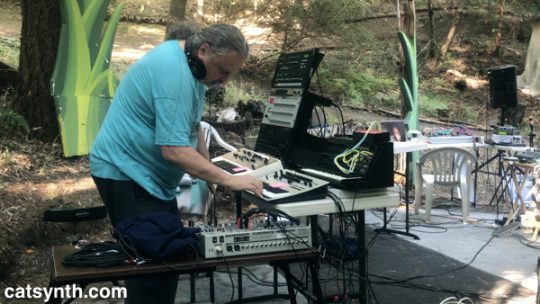
His opening piece was more traditionally harmonic compared to the preceding sets, with slowly changing harmonic patterns that evoked late-20th-century minimalism (think Steve Reich and John Adams). The second portion of the set featured some harsher sounds and noise centered around Nicholson’s modular synth.
Then it was time for me to take the stage. I brought a rig that included the large 9U modular, a Casio SK-1 and my trusty Moog Theremini.
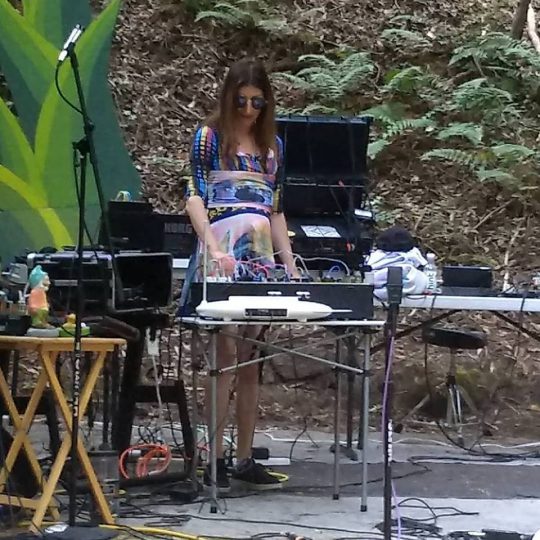
[Photo by R Duck]
As with most of my recent solo work, I select one of my more formal compositions as a point of departure. In this case, it was “White Wine”, with the melody set against one of the SK-1’s drum beats. This them morphed into a broken and complex break of sound and eventually to a pure improvisation with the modular and theremin, though the beats never really disappeared. As I was when listening to the other sets, I was thinking about the natural surroundings – in my case being the “city girl” mastering my place in space and sound, even if just for a few brief minutes.
The final set featured Lemon DeGeorge on harmonica and electronics.
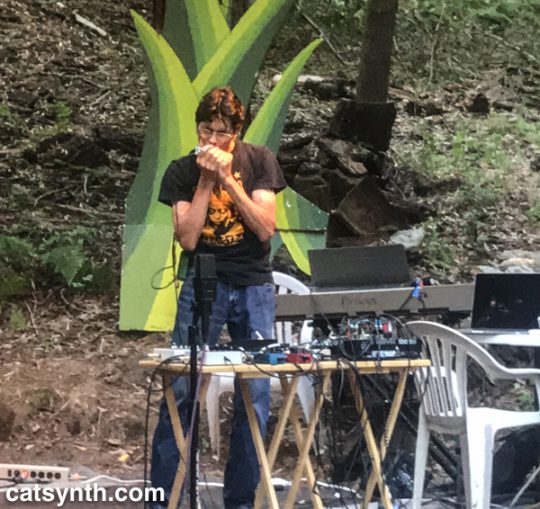
The harmonicas (like a true player of the instrument, he had more than one) added a unique dimension to the music, and the electronics followed with long breathy tones. The sounds appeared to build up layers upon layers into something heavy and enveloping, but never overwhelming. Compared to Nicholson’s sounds, DeGeorge’s lone tones and patterns were thoroughly inharmonic but no less beautiful or musical.
Overall it was a fine afternoon of weird electronic music in the woods, and not just for the music itself but for the fellowship with friends who I don’t get to see that often. I remained in the mind space of the show, the environment, and the sounds for a while on the drive back, at least until reaching I-880 and heading first into Oakland and later home to San Francisco, where I snapped back into my everyday urban life.